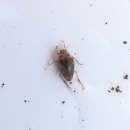
This document provides background and guidance for conducting surveys for Hungerford’s crawling water beetle (Brychius hungerfordi; HCWB) throughout its Michigan range. HCWB is a federally endangered species (59 FR 10580). The objective of these guidelines is to establish, with a reasonable level of confidence, whether HCWB is present in a proposed project area or to document status of known sites. These guidelines also describe relocation procedures to follow when projects may result in short term adverse effects to HCWB. This document also includes an identification sheet for HCWB that can be printed and laminated for use in the field, example photographs of HCWB habitat, optional forms that can be used during habitat assessments and surveys, and a flowchart that can help determine when surveys are recommended. A map of streams in HCWB habitat that may contain suitable habitat in also included in this guidance. This information is also available as a shapefile for use in ArcGIS programs and a .kmz file for use in Google Earth. If you need this spatial information in another format, please contact our office. The spatial informaiton displays streams in the current range of HCWB that may contain suitable habitat, as well as stream reaches where HCWB has been detected within 1 mile (as described in the HCWB_1mi attribute). Suitability is based on average July temperature, baseline flow, network catchment soil permeability, and a relative habitat suitability model developed by Michigan DNR. Additional streams not shown in this data file may also contain suitable habitat for HCWB.


